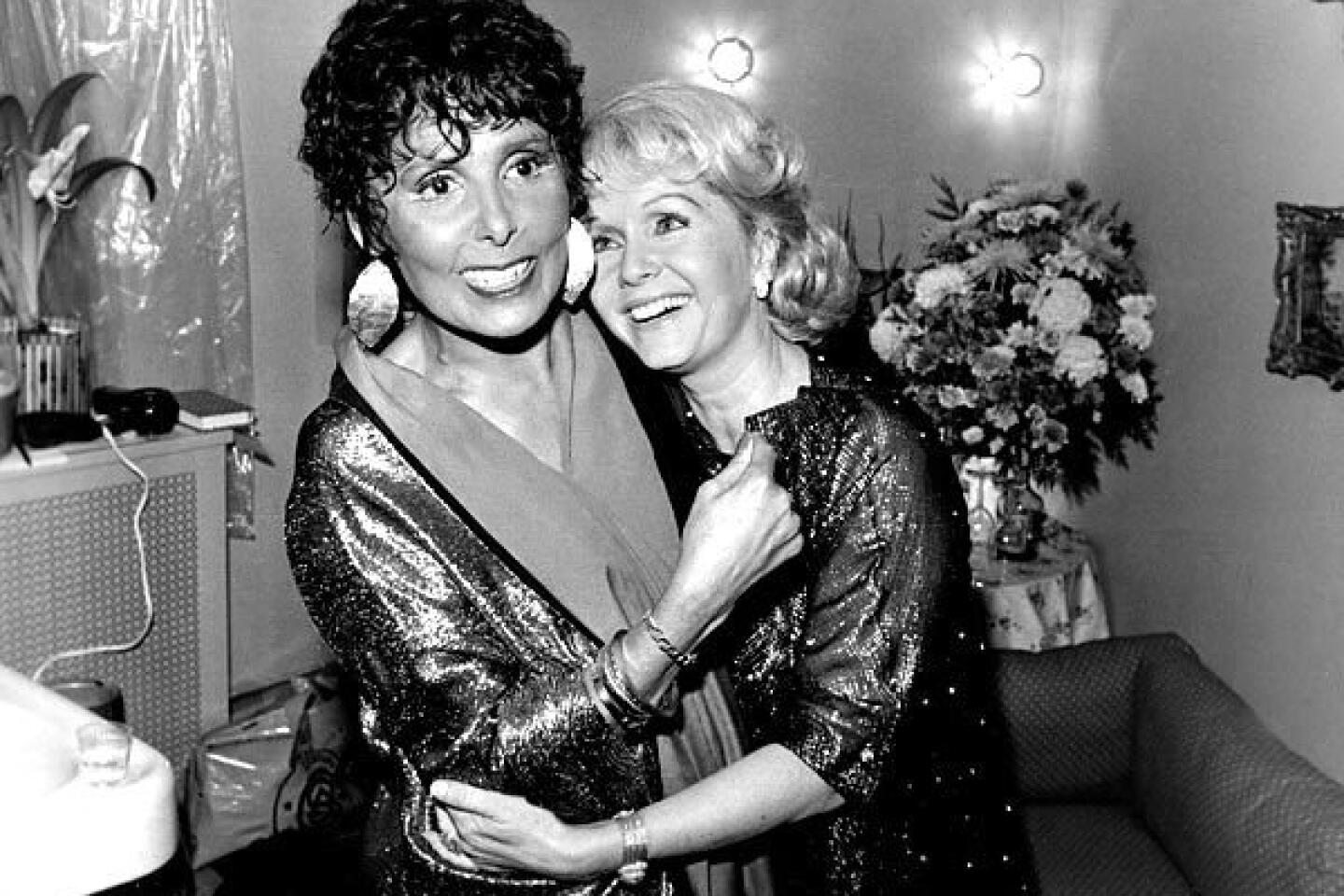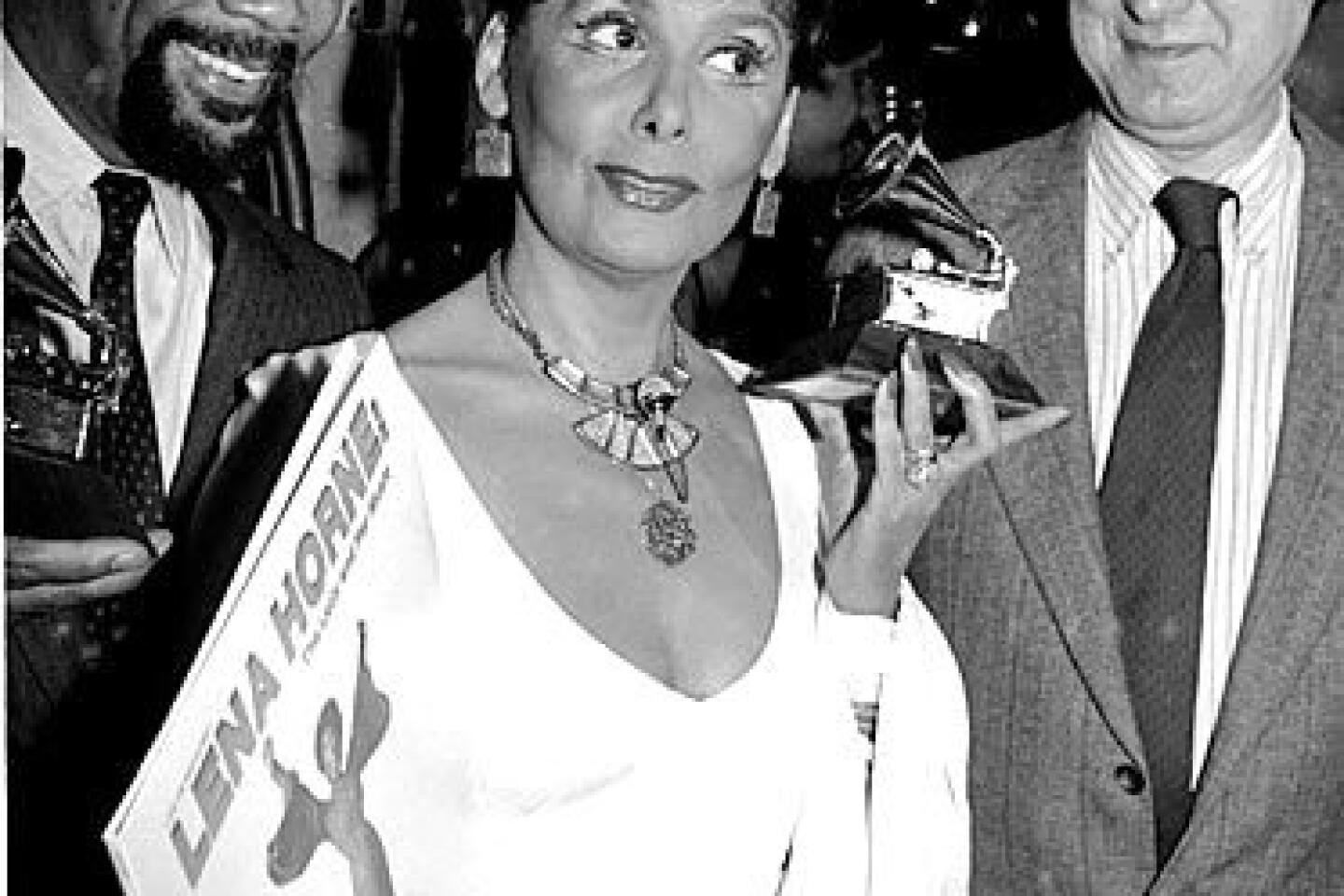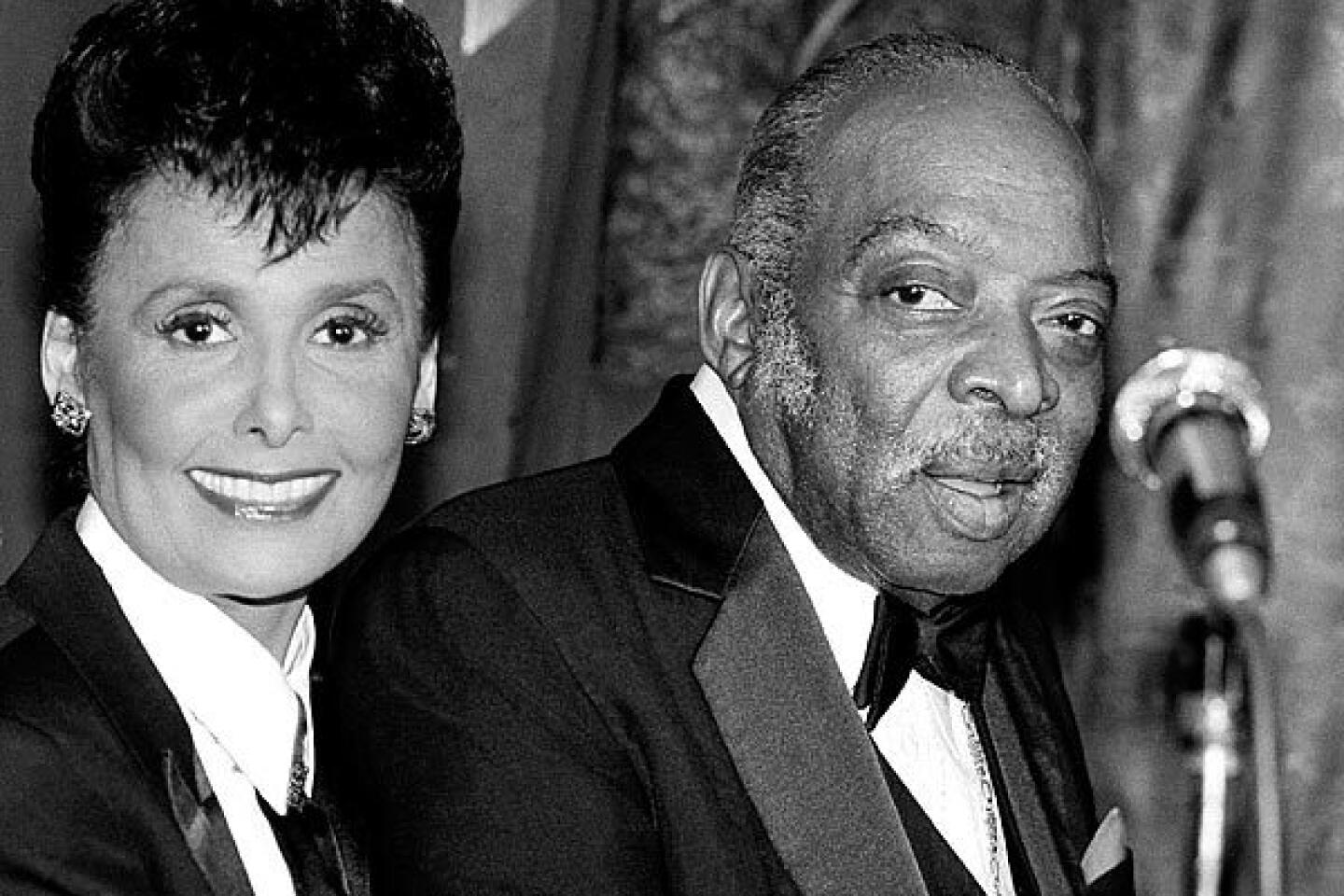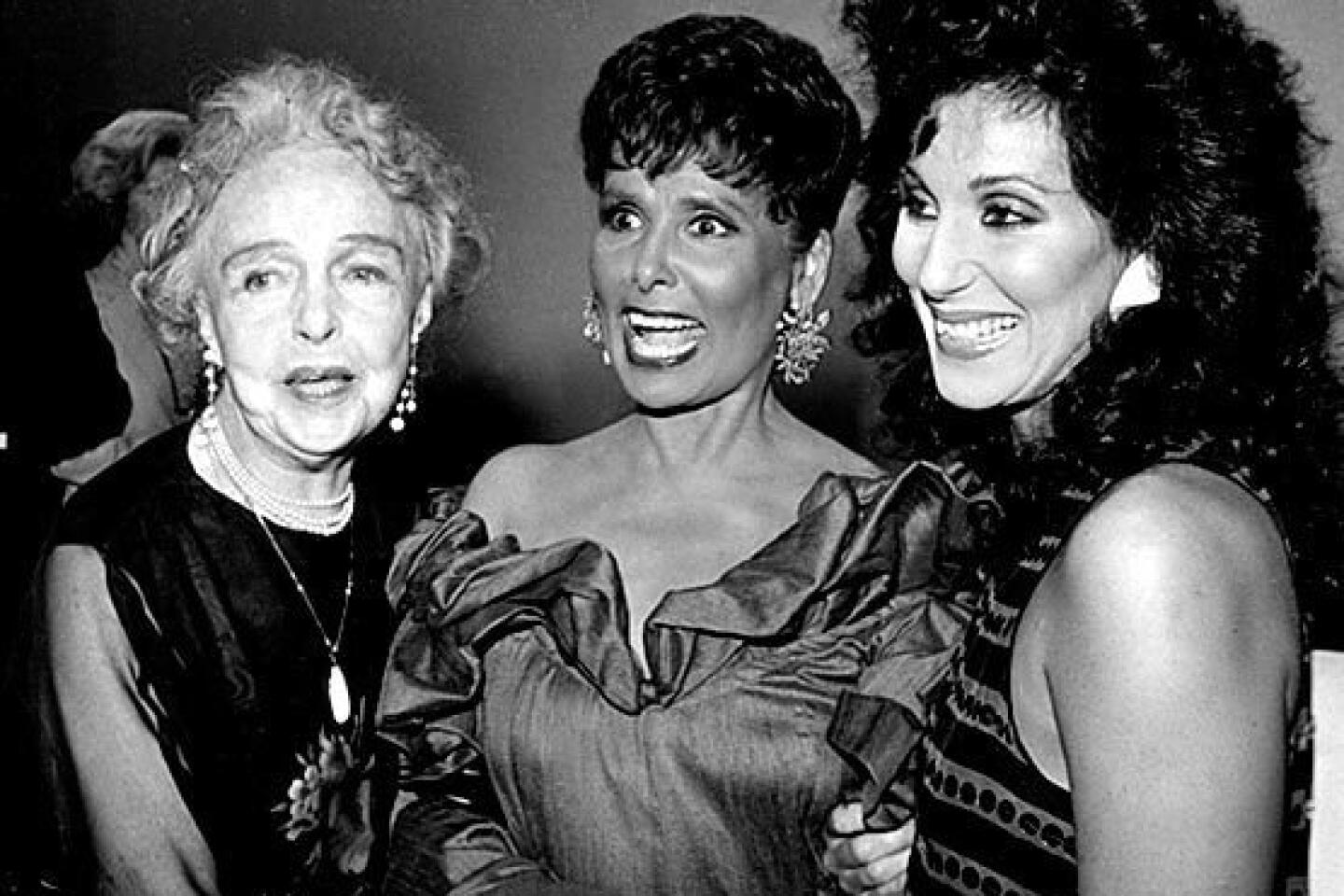From the Archives: Lena Horne dies at 92; singer and civil rights activist who broke barriers
“Stormy Weather” was Lena Horne’s signature song as well as a chillingly apt metaphor for her career. Long celebrated for her striking beauty and silky voice, she overcame profound racism on her way to becoming one of the best-known African American performers in the country.
At MGM, she had a seven-year contract in the 1940s when no other African American had such long-term deals. But her movie scenes were filmed so they could be easily excised for release in the Jim Crow South.
As a singer in the 1950s, Horne often performed for white audiences in supper clubs then cursed the audience under her breath as she took her bows, her biographer wrote last year.
The glamorous Horne would go on to be “one of the legendary divas of popular music,” jazz critic Don Heckman wrote in The Times in 1997, with a voice that almost caressed “with its warm timbre and seductive drawl,”
Horne, whose career spanned more than 60 years, died Sunday of heart failure at New York-Presbyterian/Weill Cornell Medical Center, said her daughter, Gail Lumet Buckley. She was 92.
She made “in-roads into a world that had never before been explored by African American women, and she did it on her own terms,” Grammy-winning producer Quincy Jones said in a statement. He called her “one of the great artistic icons of the 20th century.”
To help out her family during the Depression, Horne got a job as a 16-year-old chorus girl in 1933 at the fabled Cotton Club in Harlem. She went on to have a career that included film, television, Grammy-winning records, a one-woman Broadway show and untold nightclub appearances.
As a singer, she “belonged in the pantheon of great female artists” that includes Billie Holiday, Ella Fitzgerald, Sarah Vaughan and Carmen McRae, Heckman wrote in 1997.
Horne, then 80 and cutting a new album, took a different view.
“Oh, please,” she told the writer. “I’m really not Miss Pretentious. I’m just a survivor. Just being myself.”
When she arrived in Hollywood in 1941, she had already sung with the orchestra of white bandleader Charlie Barnet, making it one of the era’s few integrated swing bands. She also had been a cabaret sensation at the prestigious Cafe Society Downtown club in New York’s Greenwich Village.
At the Little Troc, a small club on the Sunset Strip, the response was similar. “She has knocked the movie population bowlegged and is up to her ears in offers,” one news account reported.
After signing with MGM, she broke through as an African American actress on the silver screen. With her copper-toned skin and dazzling smile, she was “Hollywood’s first black beauty, sex symbol, singing star,” as Vogue magazine described her decades later.
“I was unique in that I was a kind of black that white people could accept,” Horne once said and rued that she was more popular as a performer because she could “pass” for white.
Refusing to play maids or other stereotypical parts then offered to black actors, Horne had a nonspeaking role as a singer in her first MGM movie, “Panama Hattie,” a 1942 comedy.
That set the tone for much of the 1940s as she appeared in more than a dozen films, including “Swing Fever,” “Broadway Rhythm” and “Ziegfeld Follies.”
In most of them, she had cameos only as a singer and was often clad in a sophisticated evening gown, shown singing while leaning against a pillar. It became her on-screen trademark.
“They didn’t make me into a maid, but they didn’t make me into anything else either,” she wrote in “Lena,” her 1965 autobiography. “I became a butterfly pinned to a column singing away in Movieland.”
Horne’s musical numbers usually were shot independently of the films’ narratives, making them easy to be deleted later when screened in the Jim Crow South.
Two 1943 films were exceptions, the all-black musicals in which she starred — “Cabin in the Sky” and “Stormy Weather.”
Her memorable rendition of Harold Arlen and Ted Koehler’s “Stormy Weather” in the movie became a hit recording for Horne. It was also the name James Gavin chose for his 2009 biography of her.
A World War II pinup, Horne in 1944 became the first African American to appear on the cover of a movie magazine, Motion Picture.
“In the history of American popular entertainment, no woman had ever looked like Lena Horne. Nor had any other black woman had looks considered as ‘safe’ and non-threatening,” Donald Bogle wrote in his 1980 book “Brown Sugar: Over One Hundred Years of America’s Black Female Superstars.”
“The Horne demeanor — distant and aloof — suggested that she was a woman … who appeared as if all her life she had been placed on a pedestal and everything had come easily.... Reality was another matter.”
She was born Lena Mary Calhoun Horne on June 30, 1917, in Brooklyn, N.Y. Her father was a gambler who left the family when she was 3, and her mother was an actress.
Although she sometimes went on the road with her mother, Horne was largely raised by her paternal grandparents. Her “steely suffragette grandmother” trained her not to tolerate racism and emphasized ladylike dignity and precise speech, Gavin wrote.
She belonged to the “black bourgeoisie” by virtue of her light skin, refined manner and upward striving, qualities that made her acceptable to whites, Gavin told The Times.
Through her mother’s friend, Horne got a job at the Cotton Club, which led to her appearing in 1934’s “Dance With Your Gods,” an all-black drama that had a brief Broadway run.
While with the all-black Noble Sissle Society Orchestra, she made her recording debut in 1936, singing “That’s What Love Did to Me” and “I Take You.”
In early 1937, Horne married Louis Jones, a political operative who was about nine years her senior. At 19, she settled into domestic life in Pittsburgh and had a daughter and a son, Gail and Teddy. By 1940, the couple was separated and later divorced.
Money problems during the marriage prompted her to accept a co-starring role in “The Duke Is Tops,” a low-budget, 1938 African American movie musical. She also appeared in “Lew Leslie’s Blackbirds of 1939,” a short-lived Broadway revue.
After the break-up of her marriage, Horne joined the Barnet orchestra and made a hit record, “Good for Nothing Joe,” but left the band in 1941.
While under contract to MGM in the 1940s, Horne met Lennie Hayton, a staff composer and arranger at the studio who was white. Afraid of adverse public reaction, they married in Paris in 1947 but did not announce their union for almost three years.
Later, Horne said she became involved with Hayton because she thought he could be useful to her career.
“He could get me into places no black manager could,” she told the New York Times in 1981. But “because he was a nice man and because he was in my corner, I began to love him.”
But being married to a white man, whom she once said “taught me everything I know musically,” took a toll — from her impatience with black critics who questioned the marriage to her sometimes using her husband as a “whipping boy” and making him “pay for everything the whites had done to us.”
While performing at Cafe Society Downtown, Horne became friends with Paul Robeson, a singer-actor and political activist who with Walter White, a leader of the National Assn. for the Advancement of Colored People, urged her to use her talent for a larger cause than personal success.
“They told me … I had to think about sharecroppers and Pullman porters,” Horne later said. “It became my civil-rights training ground.”
Primarily because of her friendship with Robeson and her involvement with two groups named as Communist fronts, Horne lost some film, TV and radio work in the early 1950s.
But she remained focused on her critically acclaimed nightclub/cabaret act.
In 1957, “Lena Horne at the Waldorf Astoria” was RCA Victor’s biggest-selling album by a female vocalist.
By the late 1950s, Horne was back on TV and soon starring in the long-running hit Broadway musical “Jamaica,” which earned her a Tony Award nomination.
Unable to stay in the white-only hotels she performed in because she was black, Horne developed what she later described as “a toughness, a way of isolating” herself from the audience.
“There was no cuteness or coyness about her,” comedian Alan King said of Horne in the 1996 documentary “Lena Horne: In Her Own Voice.” “Lena came out there and stuck it right in their face — boom! She was radiantly and subtly brazen, saying to herself, ‘You want to take me to bed, but you won’t let me come in the front door.’ ”
Throughout her early career, Horne experienced the injustices suffered by African Americans at the time.
While touring with the USO during World War II, she was expected to entertain the white soldiers before appearing before African American troops.
A day after performing for white soldiers in an Arkansas auditorium, she returned to entertain black troops in their mess hall. When she discovered that German prisoners of war were seated in front of black soldiers, she marched off the platform, turned her back on the POWs and sang to the black soldiers in the back of the hall.
Horne’s long-suppressed anger over the treatment of blacks in white society erupted in 1960 when she overheard a drunk white man at the Luau restaurant in Beverly Hills use a racial epithet to refer to her.
Jumping up, she threw an ashtray, a table lamp and several glasses at him, cutting the man’s forehead.
When reports of her outburst appeared in newspapers across the country, Horne was surprised at the positive response, mostly from African Americans.
“Phone calls and telegrams came in from all over,” she told the Christian Science Monitor in 1984. “It was the first time it struck me that black people related to each other in bigger ways than I realized.”
Horne became more active in the civil rights movement in the early 1960s, participating in a meeting with prominent blacks with then-Atty. Gen. Robert F. Kennedy after violence in Birmingham, Ala., and singing at civil-rights rallies.
In the early 1970s, three of her family members died — her father, her son from kidney disease and her husband from a heart attack.
She withdrew in grief until King “bullied” her out of her depression, and she returned to singing and recording, Horne later said.
She toured with Tony Bennett and appeared with him on Broadway in “Tony & Lena Sing” in 1974, and played Glinda the Good Witch in “The Wiz,” the 1978 movie musical directed by Sidney Lumet, who was then her son-in-law.
In 1981, she made a triumphant return to Broadway in the hit “Lena Horne: The Lady and Her Music.” Then 63, she received a special Tony Award for her autobiographical show that ran on Broadway for more than a year and produced a Grammy Award-winning soundtrack album.
Naturally, her rendition of “Stormy Weather” was a show-stopper.
She sang the number twice, first as she had in the movie when she was in her 20s and then at the end, from the perspective of a woman in her 60s who had experienced a lifetime of love and misery.
She was a recipient of the Kennedy Center Honors in 1984.
As Horne said in “Lena Horne: In Her Own Voice”: “My life has been about surviving. Along the way I also became an artist. It’s an interesting journey. One in which music became my refuge and then my salvation.”
Besides her daughter, she is survived by five grandchildren and two great-grandchildren.
Times staff writer Elaine Woo contributed to this report.
More to Read
Start your day right
Sign up for Essential California for the L.A. Times biggest news, features and recommendations in your inbox six days a week.
You may occasionally receive promotional content from the Los Angeles Times.













